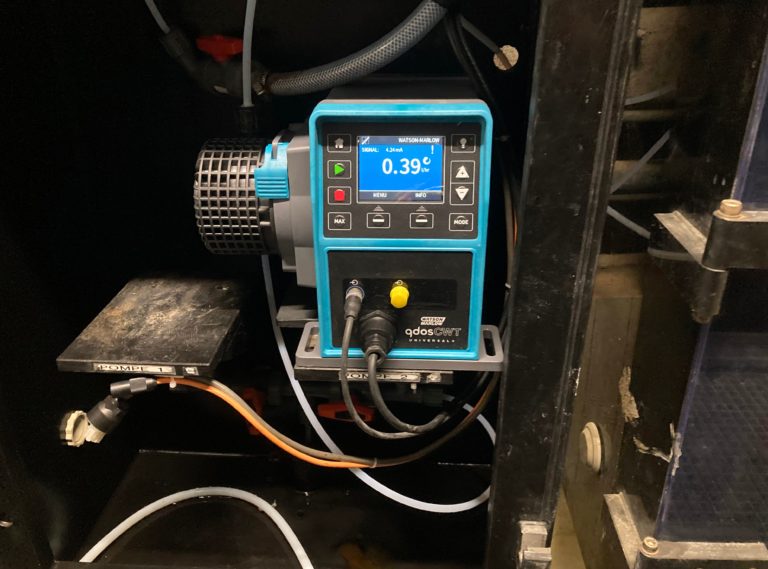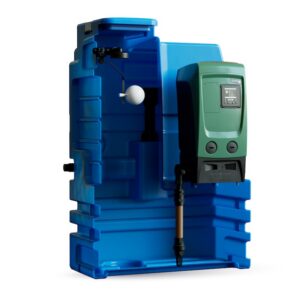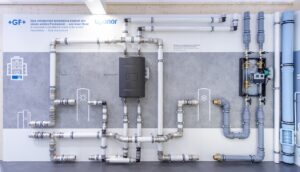Qdos CWT Pump Solves Pipeline Pressure Challenge

Qdos CWT installed at Villejean water treatment works. (Image source: Watson-Marlow Fluid Technology Group)
The Villejean water treatment plant near the city of Rennes in Brittany faced a structural challenge in adding sodium hypochlorite to a drinking water storage reservoir due to the unusually long length of the pipeline transporting the chlorine.
Watson-Marlow Fluid Technology Group (WMFTG) has worked with most of the water treatment plants in the Collectivité Eau du Bassin Rennais (Rennes Basin Water Authority) for several years. The Authority manages the entire local water system from abstraction to tap, with responsibility for maintenance, monitoring and repair for 11 treatment plants.
These assets include a 5,000m3 drinking water storage reservoir, which serves around 500,000 people in the region, distributing an average of 25,000m3 of water through the network each day. This reservoir is fed by both the Villejean plant and the Rophémel plant, which is nearby, and the water requires chlorination at 0.3mg/litre.
The plant already employs a number of Qdos pumps, each fitted with a ReNu pumphead optimised for sodium hypochlorite, sulphuric acid and hydrogen peroxide applications, with discharge pressures up to 4 bar.
The use of Qdos pumps for both sulphuric acid and hydrogen peroxide at the plant enabled fast, simple and safe maintenance compared with the diaphragm pumps deployed previously. Replacing ReNu pumpheads requires no tools, specific training or maintenance technician intervention.
However, the discharge pressure for the 15% sodium hypochlorite dosing when being added to the storage reservoir remained a concern and a priority for improvement.
For structural reasons, the sodium hypochlorite tank is located inside the Villejean plant, with chlorine distributed to various injection points throughout the facility via pumps at an adjacent location. However, the linear pipe run that brings chlorine to the water storage reservoir is 80m long and along this length chlorine degasses in the pipeline, raising the discharge pressure beyond 7 bar and causing pump accuracy problems.
WMFTG’s Qdos CWT (Conveying Wave Technology) chemical metering pump, launched globally in 2021, was initially introduced at Villejean on a trial basis in December 2020. It proved ideal in meeting the abnormally high-pressure constraints of the installation. The Qdos CWT pump offers all the advantages of a standard peristaltic pump, but with a significantly longer service life.
To achieve the peristaltic pumping action, the Qdos CWT pump incorporates an EPDM element rather than a tube, which acts against a PEEK track. The element in contact with the fluid is subject to very low stress levels, which means that the Qdos CWT pump offers significantly longer service life than a conventional alternative, even at high pressure.
In addition, Qdos CWT pumps allow the dosing of chemicals, including sodium hypochlorite for post-chlorination cycles, with high precision and regularity over the entire life of the pump. This means overdosing practices often required by other technologies to achieve a constant level of accuracy are avoided.
The Qdos CWT pump runs at 2 litre/hr on average, with a 4-20 mA input signal. The pump has already reduced the frequency of maintenance interventions at the Villejean plant, which produces 7-11 million m³ of drinking water per year, by 75% since its installation in December 2020.
Kevin Brard, operator of the Villejean water purification plant, says: "The Qdos CWT pump easily withstands overpressure in the long pipe run, as well as the aggressive nature of chlorine. As a result, its service life is significantly longer.
“We were already satisfied with the performance of Watson-Marlow’s Qdos pumps for metering of sulphuric acid and hydrogen peroxide, as well as two Bredel 50 hose pumps for lime slurry. Now we have a new Qdos CWT pump model to feed the bleach solution into our tank reliably.”







